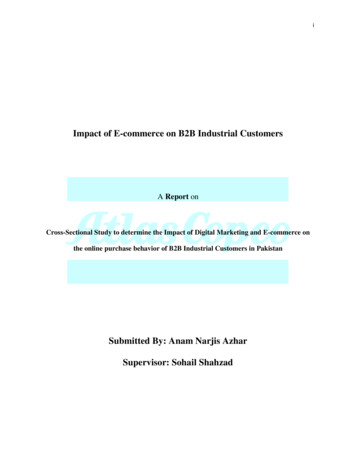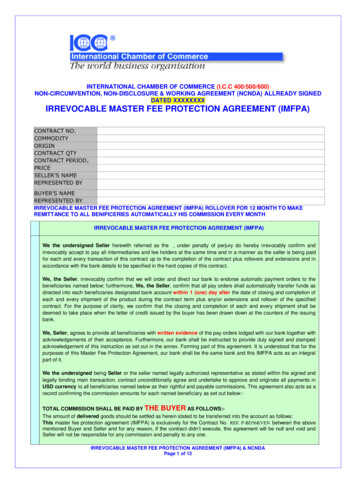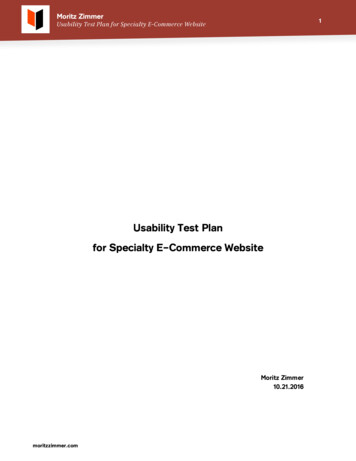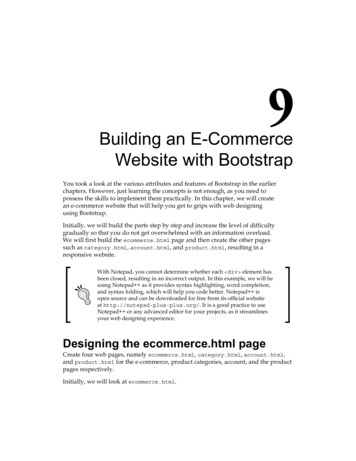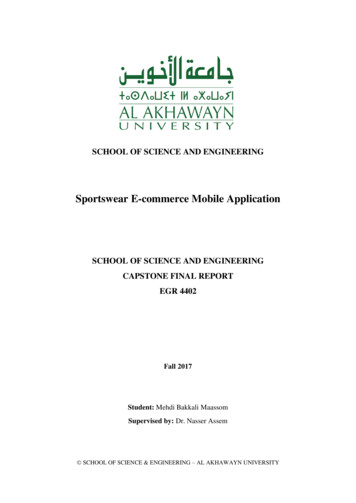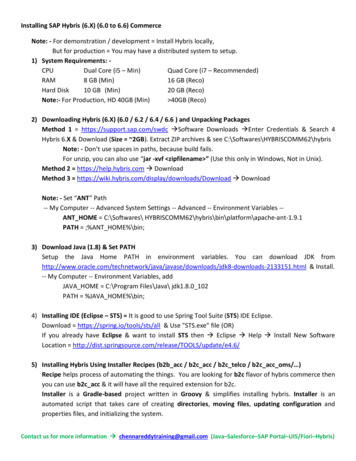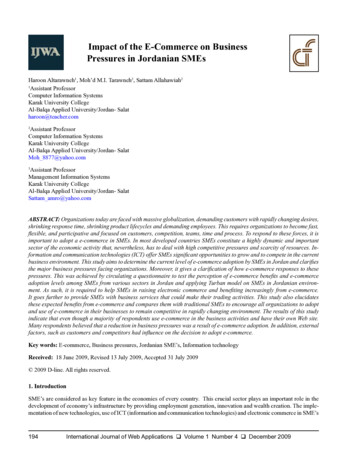
Transcription
Impact of the E-Commerce on BusinessPressures in Jordanian SMEsHaroon Altarawneh1, Moh’d M.I. Tarawneh2, Sattam Allahawiah21Assistant ProfessorComputer Information SystemsKarak University CollegeAl-Balqa Applied University/Jordan- Salatharoon@teacher.comAssistant ProfessorComputer Information SystemsKarak University CollegeAl-Balqa Applied University/Jordan- SalatMoh 8877@yahoo.com2Assistant ProfessorManagement Information SystemsKarak University CollegeAl-Balqa Applied University/Jordan- SalatSattam amro@yahoo.com3Abstract: Organizations today are faced with massive globalization, demanding customers with rapidly changing desires,shrinking response time, shrinking product lifecycles and demanding employees. This requires organizations to become fast,flexible, and participative and focused on customers, competition, teams, time and process. To respond to these forces, it isimportant to adopt a e-commerce in SMEs. In most developed countries SMEs constitute a highly dynamic and importantsector of the economic activity that, nevertheless, has to deal with high competitive pressures and scarcity of resources. Information and communication technologies (ICT) offer SMEs significant opportunities to grow and to compete in the currentbusiness environment. This study aims to determine the current level of e-commerce adoption by SMEs in Jordan and clarifiesthe major business pressures facing organizations. Moreover, it gives a clarification of how e-commerce responses to thesepressures. This was achieved by circulating a questionnaire to test the perception of e-commerce benefits and e-commerceadoption levels among SMEs from various sectors in Jordan and applying Turban model on SMEs in Jordanian environment. As such, it is required to help SMEs in raising electronic commerce and benefiting increasingly from e-commerce.It goes further to provide SMEs with business services that could make their trading activities. This study also elucidatesthese expected benefits from e-commerce and compares them with traditional SMEs to encourage all organizations to adoptand use of e-commerce in their businesses to remain competitive in rapidly changing environment. The results of this studyindicate that even though a majority of respondents use e-commerce in the business activities and have their own Web site.Many respondents believed that a reduction in business pressures was a result of e-commerce adoption. In addition, externalfactors, such as customers and competitors had influence on the decision to adopt e-commerce.Key words: E-commerce, Business pressures, Jordanian SME’s, Information technologyReceived: 18 June 2009, Revised 13 July 2009, Accepted 31 July 2009 2009 D-line. All rights reserved.1. IntroductionSME’s are considered as key feature in the economies of every country. This crucial sector plays an important role in thedevelopment of economy’s infrastructure by providing employment generation, innovation and wealth creation. The implementation of new technologies, use of ICT (information and communication technologies) and electronic commerce in SME’s194International Journal of Web Applications Volume 1 Number 4 December 2009
with their operational environment has provided numerous organizational opportunities. Akkeren and Cavaye [1] state thate-commerce improves an SME’s ability to compete with larger organizations and operate on an international scale. Theyalso see e-commerce as a tool for providing cost effective ways for SME’s to market their business, launch new products,improve communications, gather information and identify potential business partners. The Internet allows small businessesto enter the domain of larger business and compete with them. Moreover, the use of e-commerce enables small businesses toachieve the same efficiencies as large businesses. In spite of this, previous studies suggest that the adoption of web-enabledtransaction processing by small business has not been as widespread as would have been expected [2].Organizations today are faced with massive globalization, demanding customers with rapidly changing desires, shrinkingresponse time, shrinking product lifecycles and demanding employees. This requires organizations to become fast, flexible,and participative and focused on customers, competition, teams, time and process [3]. To respond to these forces, it is important to adopt a e-commerce in SMEs. To remain competitive, SMEs must globalize. SMEs’ globalization processes include arange of cross border activities, such as trade, international investment, and participation in strategic alliances, partnershipsand networking arrangements affecting a variety of business functions ranging from research and product development todistribution [4]. Turban has suggested a model that clarifies the major business pressures facing organizations and the roleof e-commerce in reducing these pressures. In this research, we will apply this model on SMEs in Jordanian environment tohelp it to start electronic business and benefit increasingly from it and to provide them with business services that could maketheir trading activities easier.2. Problem statementSmall businesses differ from large businesses due to their lack of experience with information systems, dependence on external resources for technical support, and relatively less investment in information systems. Some factors attributing to slowadoption of ICT and e-business by small businesses may include lack of management support for e-business projects, andexternal problems, for example customer service representatives who are accustomed to doing their jobs the old way and notwanting to change[5]. It is therefore imperative for SMEs to have a clear understanding of the opportunities that e-commerceis offering, as well as understanding the related requirements for the implementation of e-commerce.In most developed countries SMEs constitute a highly dynamic and important sector of the economic activity that, nevertheless, has to deal with high competitive pressures and scarcity of resources. Information and communication technologies(ICT) offer SMEs significant opportunities to grow and to compete in the current business environment.Turban [6] suggested Major Business Pressure’s model and the role of e-commerce in reducing these pressures. He dividedthese pressures into Market and Economic pressures, Technological Pressures, and Societal and environmental pressures.Each one of them has sub pressures as shown in figure (1). Therefore, it has become necessary to a clear understanding ofthe opportunities that e-commerce is offering, as well as understanding how e-commerce can reduce the business pressuresin SMEs . So in this research we will apply this model on SMEs in Jordanian environment to help them to raise electronicbusiness and benefit increasingly from them. Moreover, e-commerce provides them with business services that could maketheir trading activities and compare these expected benefits from e-commerce with traditional SMEs.3. The objectives of the studyThis study aims to determine the current level of e-commerce adoption by SMEs in Jordan and clarifies the major business pressures facing organizations. Moreover, it gives a clarification of how e-commerce responses to these pressures. Thiswas achieved by circulating a questionnaire to test the perception of e-commerce benefits and e-commerce adoption levelsamong SMEs from various sectors in Jordan and applying Turban model on SMEs in Jordanian environment. As such, it isrequired to help SMEs in raising electronic commerce and benefiting increasingly from e-commerce. It goes further to provideSMEs with business services that could make their trading activities. This study also elucidates these expected benefits frome-commerce and compares them with traditional SMEs to encourage all organizations to adopt and use of e-commerce intheir businesses to remain competitive in rapidly changing environment.4. Literature ReviewScupola [7] in his study The Adoption of Internet Commerce by SMEs in the South of Italy: An Environmental, Technologicaland Organizational Perspective found that competitive pressure, customer and supplier pressure, role of government, qualityInternational Journal of Web Applications Volume 1 Number 4 December 2009195
Figure 1. Major business pressures and the role of ECof access to e-commerce related services were important factors influencing e-commerce adoption. Innovation champion,financial resources and employees’ IS knowledge were among the most important organizational characteristics. Regarding thetechnological context he found three groups of factors influencing e-commerce adoption: e-commerce barriers, e-commercebenefits and e-commerce related technologies.Iacovou [8] identified three major factors responsible for EDI adoption. They are organizational readiness, operationalizedas financial and technological resources of the firm; external pressures divided into competitive pressure and imposition bytrading partners and perceived benefits of the technology. By investigating seven case studies of small businesses, Iacovouconcluded that “a large number of small organizations tend to lack the needed high organizational readiness and perceivedbenefits that are required for integrated, high impact systems” and that a major reason for small companies to adopt EDI isthe external pressure by trading partners.Three major drivers behind the adoption of e-commerce technologies were identified: perceived benefits, organizationalreadiness, and external pressure. several studies have looked at limited segments of the business environment in an attemptto identify the benefits of e-commerce to SMEs. These efforts have generally been restricted to qualitative evaluations ofspecific e-commerce endeavors [9][10][11].Marguerite and Marie[12] argues that local and global business pressures generate the need for continual product and processinnovation. Their paper discussed the challenges of transferring academic knowledge and research into SMEs, and demonstratesthe appropriateness of the TCS model for transferring knowledge into SMEs. They concluded that the model works principallybecause of the collaborative design of TCS. This makes it particularly effective in the SME context because tapping into university resources allows SMEs to access otherwise unobtainable knowledge that can be applied in the industrial environment.Technology transfer through the TCS Scheme or through the MSc by Learning Contract is driven by SME business need. Thisencourages the uptake of academic knowledge by SMEs and gives a practical focus to the academic’s research.Bui et al [13] argue that technology and societal changes are moving the global market rapidly towards a new economicorder rooted in e-Commerce. They investigate some factors including macro economy, ability to invest, access to skilledworkforce, cost of living and pricing. The authors also state that many organisations face a chronic shortage of resources(including funding). Management should be aware that e-Business is part of the complex and general economic structure andthe success of organisations depend on that structure as well as the optimum allocation of resources.The 2004 OCED [4] Report suggested that increased levels of globalisation can impact on SMEs in two main ways. Onthe one hand they open up opportunities. For example, SMEs that can grow quickly, that are niche exporters, or are able totie in with global supply chains are all able to take advantage of opportunities created by globalisation. On the other hand,196International Journal of Web Applications Volume 1 Number 4 December 2009
globalisation poses an increased threat for SMEs that are unable or unwilling to compete. Given that labour is still less“globalised” than other factors, this poses political and social challenges for governments.5. MethodologyThe study has adapted the descriptive, field and analytic methods. A comprehensive survey and analyzing data that collectedfrom questionnaires by using statistical ways were conducted to implement the field analytic research. The study based on adeveloped questionnaire that organized depending on the previous questionnaires; this questionnaire has adjusted to fit theJordanian environment.6. Population of the studyThe study population contains from all SMEs in Jordan which are listed in ASE up to the end of 2008 that work in main sectorsand classified as the following: banks, insurance, brokerage firms, industrial, services firms, and firms in other sectors. Whichrepresent the individuals, managers, assistants’ managers, brokerage managers, and top managers in the listed firms in ASE.6.1 SampleThe sample contains of (50) firms which are banks, insurance, financial, industrial, and services firms, continuously listed inASE, as shown in the table (4.1) below. The simple random sample was selected from managers of banks, insurance, industrial, trading, services, and financial firms. The questions were responded by the responsible chairmen, managers, assistantmanagers, and employee in the mentioned companies.Institution/sectorNumber of firmsBanks sectors12Services sector11Insurance sector10Manufacturing sector8Other sectors9Total50Table 1. Sample of the studyIt has chosen a convenient sample from the study population, the sample included total (400) observations, which were distributed to the respondents as the following: banks financial company (110), insurance (70), industrial (65), services firms(75), and other sectors (85), the returned questionnaires were (289); (27) questionnaires were excluded because they weren’tvalid for statistical analysis, so the valid questionnaires were 262 (65%).Majority of questionnaires distributed on banks and financial firms, this return for several reasons: The rapid developments of technology in banking and financing sector. The growing role of banking sector in economy. The both sector has a good quality of employees and managers.7. Results and discussion7.1 Demographic characteristics of RespondentsThis section presents an analysis of the responses to business pressures in SMEs in Jordan. Descriptive information regardingfirm size, number of years the respondents has been with the firm and in the current position, gender, age, educational level,and other demographic data were collected in the survey instrument. Demographic variables were modeled as nominal scalesand open-ended ratio scales (only for number of years respondents have been with the firm and in the current position). Thevariables designed by ratio scales were recoded into nominal scales and analyzed.International Journal of Web Applications Volume 1 Number 4 December 2009197
The summary of demographic variables is reported in previous section. The following discussion compares the major demographic variables collected in the study.Most of the respondents were male (69, 5 %) with ages ranging from 36 to 50 years (40.5%). Education levels revealedthat (54.6%) of the respondents had a 4-year college degree and (22.9%) had a master degree. After recoding the numberof years a respondent had been with the firm, results showed that a high percentage of the respondents experience between7-10years.Accordingly, results showed that (47.3%) of the respondents worked in higher current Position; these results gave us a highmotivation to implement this study. Firm’s characteristics revealed that (25.9%) of the companies had between 10 and 100Employees and (48.4%) had between 101 and 249. The number of employees of the collected samples is all less than 250.This indicates that the collected data is suitable for the study of SMEs. Concerning the sectors variable, the results showedthat the different variables were close in ratio to each other.7.2 Analysis of HypothesisIn addition to the descriptive analysis applied in order to understand better the characteristics of the sample, statistical testswere used to examine the relation between the independent variable (e-commerce adoption by SMEs in Jordan) and dependent variables, such as Market and economic pressures, Societal and environmental pressures and Technological pressures.Following is a review of each hypothesis:Hypothesis (1): stated that e-commerce positively effect on reducing major business pressures in SMEs in Jordan.A single population proportion test was performed to determine the statistical significance of the extent of effect e-commerceon reducing business pressures. The results of the testing of the first hypothesis are presented. The test was significant at the0.01 level. The researcher, therefore, rejected the null hypothesis and accepted the alternative hypothesis. The research findingsare statistically significant in the explanation of the extent of e-commerce by SMEs for business solutions and support thehypothesis that a majority use the e-commerce for reducing business pressures. Feedback was provided pointing out that allthe factors are important and suggested that managers perceived external pressure from people and other firms forcing themto adopt ecommerce in their companies. In other words, social and environmental pressures, market and economic pressuresand technology pressures influenced the decision to adopt or not to adopt e-commerce.Either, when comparisons are made between the reasons that may have motivated the organization to implement e-commerceand those of benefits that respondents experienced since implementing e-commerce similarities are observed. For example, amajority of respondents indicated that e-commerce improved the firm’s performance, improved competitiveness and reducingthe pressures that SMEs suffering from.Hypothesis (2): stated that E-commerce positively effect on reducing Market and economic pressures in SMEsin Jordan.A single population proportion test was performed to determine the statistical significance of the extent of effect e-commerceon reducing Market and economic pressures in SMEs in Jordan. Market and economic pressures are divided into six dimensions: Strong competition, Global economy, extremely low labor cost in some countries, frequent and significant changes inmarkets, increased power of consumers, and regional trade agreements (e.g. NAFTA). The results of the testing of secondFigure 2. business pressures198International Journal of Web Applications Volume 1 Number 4 December 2009
hypothesis are presented. The test was significant at the 0.01 level. The researcher, therefore, rejected the null hypothesis andaccepted the alternative hypothesis. The research findings support the second hypothesis. It has been noted that the variableincreases power consumer’s came in the first rank, therefore we conclude that using e-commerce in SMEs positively effecton reducing market and economic pressures especially increases consumer’s power.When comparisons are made between the reasons that may have motivated the SMEs to implement e-commerce and those ofbenefits that respondents experienced since implementing e-commerce, similarities are observed. For example, a majority ofrespondents indicated that our competitors had implemented it was both a driver as well as a benefit; a majority agreed thatdemand pressures by the supplier was both a motivator for implementing e-commerce as well as a benefit, and a majoritystrongly agree that increased revenue was both a motivator as well as an experienced benefit. Similar comparisons occurredwith issues of reaching new customers, improved marketing, and improved customer service. Conversely, a majority of respondents agreed with the statement that improved distribution channels was a motivator, but a majority also agreed that it wasa benefit. Similar comparisons were evident in addressing the issue of a higher degree of increased the electronic contracts,allowed our firm to perform more like a large company control in managing the business improved inventory managem
Al-Balqa Applied University/Jordan- Salat haroon@teacher.com 2Assistant Professor . This makes it particularly effective in the SME context because tapping into uni-versity resources allows SMEs to access otherwise unobtainable knowledge that can b
